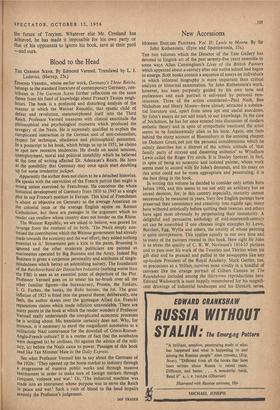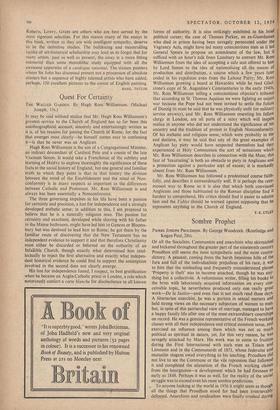New Accessions
MODERN ENGLISH PAINTERS. VOL II: Lewis to Moore. By Sir John Rothenstein. (Eyre and Spottiswoode, 35s.) THE two volumes which the Director of the Tate Gallery has devoted to English art of the past seventy-five years resemble in some ways Allan Cunningham's Lives of the British Painters which appeared about a century after our native school had begun to emerge. Both books contain a sequence of essays on individuals in which informal biography is more important than critical analysis or historical examination. Sir John Rothenstein's work, however, has been purposely guided by his own taste and preferences and each portrait is enlivened by personal rem- iniscence. Three of the artists considered—Paul Nash, Ben Nicholson and Henry Moore—have already attracted a substan- tial literature and, apart from some apt and useful anecdotes, Sir John's essays do not add much to our knowledge. In the case of Nicholson, he has for once entered into discussion of modern aesthetic theory and in spite of sympathetic treatment the artist seems to be fundamentally alien to his taste. Again, one feels behind the sharp account of Bloomsbury in the amusing chapter on Duncan Grant, not just the personal considerations which he calmly describes but a distrust of the artistic attitude of 'that family party of strayed and dissenting aesthetics' as Wyndham Lewis called the Roger Fry circle. It is Stanley Spencer, in fact, in spite of being an eccentric and isolated painter, whose work seems most to accord with Sir John's demands, and his essay on this artist could not be more appropriate and penetrating; it is the best thing in the book.
In writing this volume he decided to consider only artists born before 1900, and this seems to me not only an arbitrary but an unreal decision, for, in this country especially, maturity cannot neccessarily be measured in years. Very few English painters have preserved their consistency and creativity into middle age; many have withered artistically before quitting their twenties and others have aged most obviously by perpetuating their immaturity. A delightful and persuasive anthology of mid-nineteenth-century art can be assembled if one chooses single examples by Lewis, Burchett, Egg, Wyllie and others, the totality of whose painting is quite unimpressive. This applies equally to our own time and to many of the painters treated in this book. How right Sir John is to stress the quality of C. R. W. Nevinson's 1914-15 pictures and to pass over his work of the Twenties and Thirties when his gift died and he pranced and puffed in the newspapers like any up-to-date President of the Royal Academy. Mark Gertler, too, as precocious as a Millais, survives most vividly in a handful of canvases like the strange portrait of Gilbert Cannan or The Roundabout included among the thirty-two reproductions here. Edward Wadsworth is most happily remembered for his magnifi- cent drawings of industrial landscapes and his Dunkirk series.
Roberts, Lowry, Grant are others who are best served by the most rigorous selection. For this reason many of the essays in this book, written as they arc with intelligent sympathy, deserve to be the definitive studies. The bulldozing and steamrolling tactics of art-historical scholarship may lead us to forget that for many artists, past as well as present, the essay is a more fitting memorial than some monolithic study equipped with all the awesome apparatus of a catalogue raisonne. The sixteen painters whom Sir John has discussed present not a procession of absolute masters but a sequence of highly talented artists who have added, perhaps, 150 excellent pictures to the canon of English painting.
BASIL TAYLOR











































 Previous page
Previous page